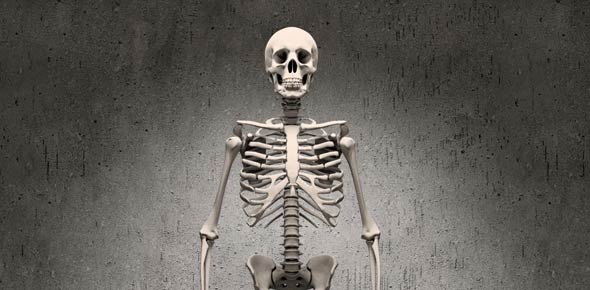Test Your Knowledge Of The Skeletal System

This quiz will test your knowledge of the Skeletal System unit of the GCSE PE course.
- 1.
Define the term 'joint'.
- 2.
Describe the term 'flexion' in relation to movement at a joint, and give an example from physical activity.
- 3.
Name the four types of fracture.
- 4.
Describe one of the types of fracture and an example of when it may occur due to physical activity.
- 5.
Which one of the following is not a joint injury?
- A.
Strain
- B.
Dislocation
- C.
Sprain
- D.
Tennis elbow
Correct Answer
A. StrainExplanation
A strain is not a joint injury because it refers to an injury to a muscle or tendon, rather than a joint. A strain occurs when the muscle or tendon is stretched or torn, usually due to overuse or excessive force. In contrast, dislocation, sprain, and tennis elbow all involve damage to the joints. A dislocation happens when the bones in a joint are forced out of their normal position, while a sprain is an injury to the ligaments that connect bones in a joint. Tennis elbow, also known as lateral epicondylitis, is a condition that causes pain and inflammation in the tendons that attach to the outside of the elbow joint.Rate this question:
-
- 6.
What are the functions of the skeletal system?
- A.
Movement, shape, body composition
- B.
Production, prevention, structure
- C.
Movement, protection, support
- D.
Muscle attachment, support, joints
Correct Answer
C. Movement, protection, supportExplanation
The skeletal system has three main functions: movement, protection, and support. The bones in our body allow us to move by providing a framework for our muscles to attach to. They also protect our internal organs, such as the skull protecting the brain and the ribcage protecting the heart and lungs. Additionally, the skeletal system provides support to our body, helping us maintain our shape and posture.Rate this question:
-
- 7.
Which statement correctly identifies the effect of calcium on the skeletal system?
- A.
Keeps the skeleton free from disease
- B.
Gives the skeleton strength
- C.
Provides the skeleton with energy
- D.
Assists the skeleton in the production of red blood cells
Correct Answer
B. Gives the skeleton strengthExplanation
Calcium plays a crucial role in maintaining the strength and integrity of the skeletal system. It is an essential mineral that is required for the proper development and maintenance of strong bones and teeth. Calcium is responsible for providing structural support to the skeleton, helping to prevent conditions like osteoporosis and ensuring that the bones can withstand physical stress and strain. Therefore, the statement "Gives the skeleton strength" correctly identifies the effect of calcium on the skeletal system.Rate this question:
-
- 8.
Which type of injury would you treat with RICE?
- A.
Fracture
- B.
Concussion
- C.
Sprain
- D.
Hypothermia
Correct Answer
C. SprainExplanation
RICE stands for Rest, Ice, Compression, and Elevation, which are commonly used to treat sprains. Resting the injured area helps prevent further damage, while applying ice reduces swelling and pain. Compression with a bandage or wrap helps stabilize the joint and reduce swelling, and elevation helps drain fluid away from the injured area. Therefore, RICE is an effective treatment for sprains.Rate this question:
-
- 9.
What does RICE stand for?
- A.
Rest, Ice, Concussion, Elevation
- B.
Recover, Ice, Compression, Elevation
- C.
Rest, Induce, Complete, Emerse
- D.
Rest, Ice, Compression, Elevation
Correct Answer
D. Rest, Ice, Compression, ElevationExplanation
The correct answer is Rest, Ice, Compression, Elevation. This acronym, RICE, is commonly used in first aid and sports medicine to remember the steps for treating acute injuries such as sprains or strains. Rest refers to avoiding further activity to prevent worsening of the injury. Ice helps reduce pain and swelling by constricting blood vessels. Compression involves applying pressure to the injured area with a bandage or wrap. Elevation helps reduce swelling by elevating the injured area above the heart.Rate this question:
-
- 10.
Which of the following correctly identifies the movement possibilities at a hinge joint?
- A.
Flexion, extension, adduction, abduction
- B.
Abduction, adduction
- C.
Abduction, adduction, rotation
- D.
Flexion, extension
Correct Answer
D. Flexion, extensionExplanation
A hinge joint allows movement in only one plane, like a door hinge. Flexion refers to bending the joint, while extension refers to straightening it. Therefore, the correct answer is flexion and extension, as these are the movement possibilities at a hinge joint.Rate this question:
-
Quiz Review Timeline +
Our quizzes are rigorously reviewed, monitored and continuously updated by our expert board to maintain accuracy, relevance, and timeliness.
-
Current Version
-
Mar 20, 2023Quiz Edited by
ProProfs Editorial Team -
Jan 20, 2015Quiz Created by
Houlty
- Aura Quizzes
- Axial Skeleton Quizzes
- Body Mechanics Quizzes
- Body Parts Quizzes
- Body System Quizzes
- Chest Quizzes
- Ear Quizzes
- Endocrine Quizzes
- Eye Quizzes
- Feet Quizzes
- Gland Quizzes
- Limb Quizzes
- Musculoskeletal Quizzes
- Pain Quizzes
- Pharmacodynamics Quizzes
- Piercing Quizzes
- Spanish Body Parts Quizzes
- Thorax Quizzes
- Urine Quizzes
 Back to top
Back to top


